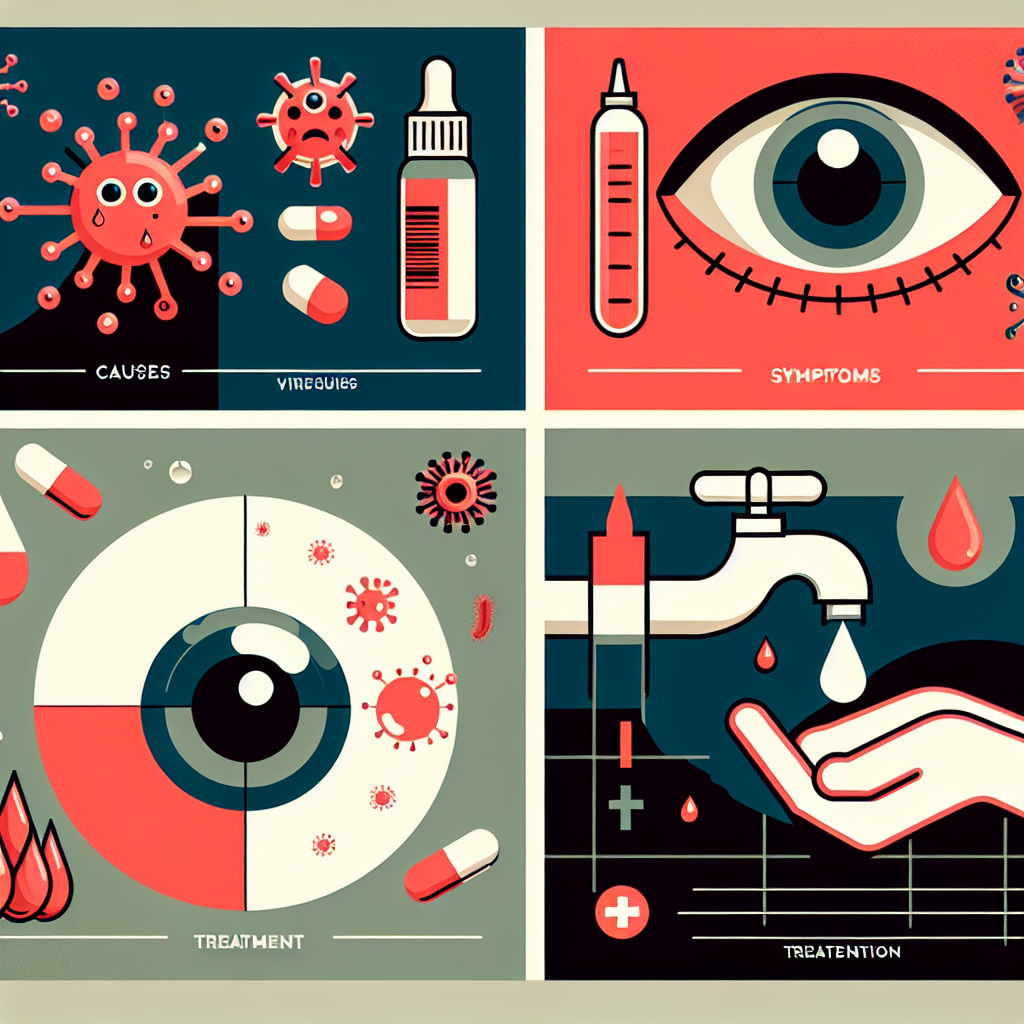What is Conjunctivitis?
The conjunctiva is a thin mucous membrane that protects the eyeball and helps hydrate the eye. When this membrane becomes irritated or infected, it’s called conjunctivitis. This inflammation causes the eye to turn red and leads to other discomforts. It can be acute, appearing suddenly for a short period, or chronic, persisting for weeks or months.
Causes and Risk Factors
Several factors can trigger conjunctivitis. Each type of conjunctivitis has specific causes:
- Viral: Viruses, particularly adenoviruses, cause this type of conjunctivitis. It often appears with a cold, sore throat, or respiratory infection. It is highly contagious.
- Bacterial: Bacteria such as staphylococci or streptococci can infect the conjunctiva. It often produces a thick, purulent discharge. It is also highly contagious.
- Allergic: This results from an allergic reaction to substances like pollen, dust mites, animal dander, or certain cosmetics. It is not contagious.
- Irritant or Toxic: Exposure to irritants such as smoke, pool chlorine, dust, or poorly maintained contact lenses can cause this form of inflammation.
Symptoms and Signs
Conjunctivitis manifests through specific signs. The affected eye or eyes become red. Other common symptoms include:
- Eye Redness: The white part of the eye takes on a pinkish or bright red hue.
- Excessive Tearing: The eyes produce too many tears.
- Itching: A sensation of discomfort or burning fills the eye.
- Gritty Sensation: A feeling like sand is in the eye.
- Discharge: In cases of bacterial conjunctivitis, a yellowish or greenish discharge appears, causing the eyelids to stick together upon waking. Viral conjunctivitis produces a clear, watery discharge. For allergic conjunctivitis, tearing is often clear.
- Light Sensitivity (Photophobia): Bright light becomes uncomfortable.
Diagnosing Conjunctivitis: How is the Condition Detected?
A general practitioner or an ophthalmologist usually diagnoses conjunctivitis through a clinical examination. They assess symptoms and examine the eye with a headlamp or a biomicroscope (slit lamp).
In most cases, a visual diagnosis is sufficient. However, in cases of severe symptoms, suspected rare infection, or if standard treatments are ineffective, the doctor may take a sample of ocular secretions. This sample is then analyzed in a laboratory to precisely identify the responsible germ (bacteria, virus) or confirm an allergic cause.
Treatments and Management
The treatment for conjunctivitis depends on its cause:
- Viral: There is no specific treatment for most viral conjunctivitis cases. Healing usually occurs spontaneously within one to two weeks. Cold compresses and artificial tears can relieve symptoms.
- Bacterial: The doctor prescribes antibiotic eye drops or ointments. Improvement is rapid, often within a few days.
- Allergic: Treatments using antihistamine or anti-inflammatory eye drops soothe itching and redness. Avoiding the allergen is crucial.
- Irritant: Eye washes and elimination of the irritant provide relief.
In all cases, good eye hygiene, such as frequent washing with saline solution, reduces discomfort and prevents the spread of infections.
Recent Scientific Advancements
Research into conjunctivitis remains very active. In the first half of 2025, efforts are particularly focused on developing new rapid diagnostic tools. These tools would allow for quicker identification of the pathogen (viral or bacterial) at the first symptoms, leading to more targeted management and avoiding unnecessary antibiotic use. Studies are also exploring new therapeutic approaches for chronic or recurrent forms of allergic conjunctivitis, seeking solutions beyond traditional antihistamines. Growing attention is being paid to the impact of environmental factors on the incidence of conjunctivitis, particularly air pollution.
Preventing Conjunctivitis: Is it Possible to Reduce Risk?
Yes, simple measures effectively prevent conjunctivitis and limit its spread:
- Hand Hygiene: Wash your hands frequently, especially after touching your eyes or an ill person.
- Avoid Rubbing Eyes: Avoid touching or rubbing your eyes to prevent introducing germs.
- Avoid Sharing Items: Do not share towels, eye makeup, or personal items with affected individuals.
- Lens Care: Strictly adhere to hygiene rules for contact lenses.
- Avoid Allergens: For allergic conjunctivitis, reduce exposure to irritating substances.
Living with Conjunctivitis
Conjunctivitis is generally a benign condition and does not affect long-term vision. However, it causes significant discomfort. During the healing period, maintaining good eye hygiene is paramount. Do not use eye makeup and avoid wearing contact lenses. If conjunctivitis does not improve or worsens after a few days, consult your physician again. This could indicate other underlying conditions or resistance to initial treatment.
Frequently Asked Questions (FAQ)
Is conjunctivitis contagious?
Viral and bacterial conjunctivitis are highly contagious. They spread through direct or indirect contact with ocular secretions from an infected person. Allergic or irritant conjunctivitis, however, is not contagious.
How long does conjunctivitis last?
The duration varies depending on the type of conjunctivitis. Viral or bacterial conjunctivitis typically lasts one to two weeks. Allergic conjunctivitis persists as long as exposure to the allergen continues. Appropriate treatment can shorten these durations.
When should I see a doctor?
Consult a doctor if symptoms are severe, if vision is affected, if pain is intense, if conjunctivitis does not improve after a few days of local treatments, or if you suspect a foreign body in the eye. Infants and young children with conjunctivitis require prompt medical attention.
Can I wear contact lenses with conjunctivitis?
No. Wearing contact lenses is strongly discouraged in cases of conjunctivitis. It can aggravate the irritation or infection. Wait for complete healing before resuming use.
Additional resources
- To extend your knowledge, more articles are available here.
Confused by your blood test results?
Get instant clarity. AI DiagMe interprets your blood test results online in minutes. Our secure platform translates complex medical data into an easy-to-understand report. Take control of your health today. Visit aidiagme.com to get your personalized insights now.

